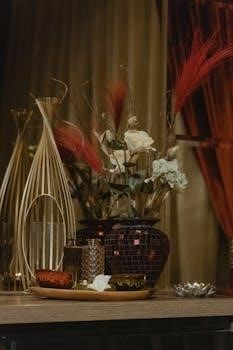interior design questionnaire for clients pdf
- Published
- in PDF
Interior Design Client Questionnaire⁚ A Comprehensive Guide
Embark on a seamless design journey with a comprehensive client questionnaire. This tool is essential for interior designers, enabling them to gather crucial insights into client preferences, project specifics, and lifestyle. It ensures tailored designs and smoother collaboration, ultimately leading to satisfying outcomes.
Purpose of an Interior Design Questionnaire
The primary purpose of an interior design questionnaire is to gather comprehensive information about a client’s needs, preferences, and vision for their space. It serves as a crucial tool for interior designers to understand the client’s desired style, functional requirements, budget constraints, and project timeline. By collecting these essential details upfront, the questionnaire helps designers tailor their services to meet the client’s specific needs and expectations.
Furthermore, the questionnaire facilitates effective communication between the designer and the client, ensuring that both parties are on the same page from the outset. It minimizes misunderstandings and potential conflicts by clarifying the scope of the project, design preferences, and any specific concerns the client may have. This structured approach streamlines the design process, allowing designers to create personalized and satisfying spaces that reflect the client’s unique personality and lifestyle.
Ultimately, an interior design questionnaire is an invaluable asset for designers seeking to deliver exceptional results and build strong, lasting relationships with their clients.
Key Elements of a Client Questionnaire
A well-structured interior design client questionnaire encompasses several key elements to effectively capture the client’s vision and requirements. Firstly, it should include a section for client contact information, ensuring easy communication throughout the project. Secondly, detailed questions about the client’s home, lifestyle, and how they intend to use the space are essential for understanding their functional needs.

Style and design preferences form another crucial element, exploring the client’s aesthetic tastes, preferred materials, and inspirational images. Color palette preferences should also be addressed to gauge their desired ambiance and mood. Budget considerations are vital for setting realistic expectations and guiding design choices. Project timeline and scheduling inquiries help manage project milestones effectively.
Furthermore, the questionnaire should delve into specific functional requirements and needs, such as accessibility considerations or storage solutions. Addressing any apprehensions or concerns the client may have ensures open communication and builds trust. By incorporating these key elements, the questionnaire becomes a comprehensive tool for gathering valuable insights and facilitating successful interior design projects.
Client Contact Information
The initial section of any comprehensive interior design client questionnaire should meticulously gather essential client contact information. This foundational step ensures seamless and efficient communication throughout the entire design process. At a minimum, this section must include fields for the client’s full name, ensuring proper identification and personalization in all interactions and documentation. A reliable phone number is crucial for quick updates, urgent discussions, and scheduling appointments.
Furthermore, a valid email address is indispensable for sharing detailed information, design proposals, and digital communications. Consider including a field for preferred method of contact, allowing clients to indicate their most convenient way to receive updates, whether it’s phone calls, emails, or text messages. An alternative contact person and their details can also be included as a backup in case the client is unavailable; Finally, a section to confirm the client’s time zone is crucial, especially when working across different geographical locations, to ensure timely and relevant communication.
Home Information and Lifestyle
Delving into the specifics of the client’s home and lifestyle is crucial for creating a functional and aesthetically pleasing design. This section of the interior design questionnaire should gather details about the property itself, including the type of residence (apartment, house, condo), its location, and its approximate square footage. Understanding the number of occupants, including adults, children, and pets, is essential for space planning and material selection.
Gather information regarding the client’s lifestyle habits and daily routines helps to ensure the design aligns with their needs; Questions about how they use the space, whether for relaxation, work, entertaining, or hobbies, provide valuable insights. Understanding the client’s storage needs, preferences for organization, and any specific accessibility requirements are also important. Furthermore, inquiring about their typical daily routines, how often they entertain guests, and any special needs or considerations ensures the final design is not only beautiful but also highly functional and tailored to their unique way of life.
Style and Design Preferences
Uncovering a client’s aesthetic inclinations is paramount in interior design. This section of the questionnaire aims to elicit their style and design preferences, ensuring the final result resonates with their personal taste. Begin by asking about preferred styles⁚ modern, traditional, minimalist, bohemian, or eclectic. Encourage clients to describe their vision using descriptive words, phrases, or even images from magazines or online platforms like Pinterest or Houzz.

Inquire about specific furniture preferences, such as materials (wood, metal, fabric), shapes, and sizes. Understanding their affinity for certain patterns, textures, and decorative elements provides further insight. Ask about existing furniture or artwork they wish to incorporate into the new design. Knowing what they love about their current space and what they dislike helps refine the design direction. Furthermore, asking about interiors they admire, whether in homes, hotels, or restaurants, reveals their aesthetic sensibilities and ensures the design aligns with their unique style.
Color Palette Preferences
Color plays a pivotal role in interior design, shaping the ambiance and reflecting the client’s personality. This section of the questionnaire delves into their color palette preferences, ensuring the design aligns with their emotional connection to hues. Start by inquiring about their favorite colors and any colors they dislike or find overwhelming.
Explore the desired mood or feeling they wish to evoke in the space, as colors significantly influence emotions. Ask about their preference for warm tones (reds, oranges, yellows), cool tones (blues, greens, purples), or neutral palettes (whites, grays, beiges). Encourage clients to provide examples of color schemes they admire, either from images or existing spaces. Inquire about their comfort level with bold or vibrant colors versus more subdued and calming shades. Understanding their preferences for accent colors and their willingness to experiment with different color combinations will further refine the palette. Finally, consider the existing architectural elements and natural lighting in the space, as these factors can impact how colors appear and feel.

Budget Considerations

Establishing a clear understanding of the client’s budget is paramount for a successful interior design project. Transparency from the outset prevents misunderstandings and ensures realistic expectations. Begin by asking the client to define their overall budget for the project, emphasizing that this figure should encompass all aspects, including design fees, materials, labor, and any potential contingencies.
Break down the budget allocation by asking the client to estimate how much they are willing to spend on specific areas, such as furniture, lighting, flooring, and décor. This granular approach provides valuable insights into their priorities and helps guide resource allocation. Discuss the potential for unexpected costs or overruns and explore options for managing them, such as setting aside a contingency fund or phasing the project. Additionally, inquire about their financing options and whether they have any constraints regarding payment schedules. By openly addressing budget considerations, designers can tailor their proposals to align with the client’s financial capabilities and deliver exceptional results within the agreed-upon framework.
Project Timeline and Scheduling
Defining a realistic project timeline and schedule is crucial for managing expectations and ensuring timely completion. Begin by inquiring about the client’s desired completion date and any specific deadlines they may have. Discuss the various phases of the project, including design development, material selection, procurement, and installation, and estimate the time required for each phase. Identify any potential constraints or factors that could impact the timeline, such as material availability, contractor schedules, or seasonal considerations.
Establish clear communication protocols for keeping the client informed of progress and any potential delays. Consider using project management tools to track tasks, deadlines, and milestones, ensuring transparency and accountability. Discuss the client’s availability for meetings, approvals, and site visits, and factor these into the schedule. Be prepared to adjust the timeline as needed based on unforeseen circumstances or changes in scope, but always communicate these changes to the client promptly and transparently. By collaboratively developing a well-defined project timeline and schedule, designers can minimize disruptions and ensure a smooth and efficient design process.
Functional Requirements and Needs
Understanding the functional requirements of the space is paramount. An interior design questionnaire should delve into how the client intends to use the space daily. Ask about their lifestyle, hobbies, and routines. For example, if designing a living room, inquire about their entertainment habits, such as movie nights or hosting guests. For a home office, understand their work style, need for storage, and technological requirements.
Explore the client’s specific needs, such as accessibility requirements for family members with disabilities or special needs. Determine if they have pets and, if so, what considerations are necessary, such as durable and easy-to-clean materials. Inquire about storage needs, including the types of items to be stored and preferred storage solutions. Discuss the importance of lighting, ventilation, and acoustics. Determine how many people will use the space regularly and how they will interact within it. By carefully considering these functional requirements, the design will enhance the client’s quality of life.
Apprehensions and Concerns
Addressing potential apprehensions and concerns is a crucial aspect of any successful interior design project. The questionnaire should include questions that allow clients to voice their worries and uncertainties openly. Some clients may be concerned about the budget, while others may worry about the timeline or the disruption to their daily lives during the renovation process.
It’s essential to address concerns about the designer’s ability to capture the client’s vision accurately. Clients might also fear making irreversible design choices they later regret. Discussing these concerns upfront allows the designer to provide reassurance and solutions. Offer guarantees, such as revisions or material samples, to alleviate their fears. Explain the design process thoroughly, ensuring the client feels involved and in control. Transparency and open communication are key to building trust and confidence. Emphasize the collaborative nature of the project, highlighting the designer’s commitment to delivering a space that meets and exceeds the client’s expectations.
Using a Questionnaire Template
Leveraging a questionnaire template streamlines the process of gathering essential client information, saving time and ensuring consistency. A well-designed template provides a structured format, covering all necessary aspects of the project, from client preferences to budget considerations.
When selecting a template, consider its comprehensiveness and adaptability. Ensure it covers all relevant areas, including style preferences, functional requirements, and budgetary constraints. Customize the template to align with your specific design process and client needs. Add or modify questions to address unique project considerations. Distribute the template electronically for easy completion and submission. Review the responses thoroughly, identifying key themes and potential challenges. Use the gathered information to develop a tailored design proposal that addresses the client’s specific requirements. A questionnaire template is a powerful tool, ensuring a smooth and efficient design process, resulting in client satisfaction.
